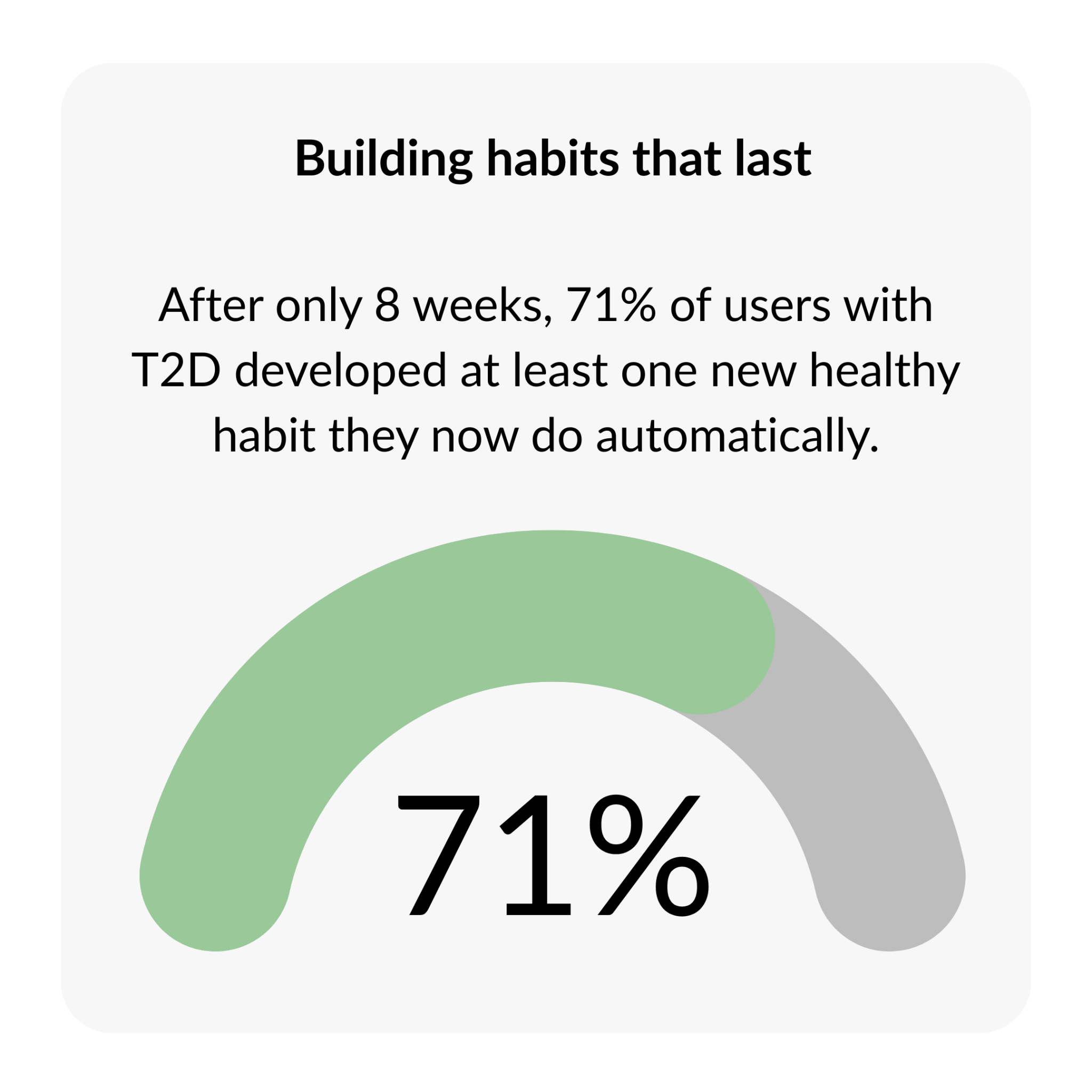Beyond the Diagnosis: Empowering People with Type 2 Diabetes Through Sustainable Habit Change
Lifestyle plays an important role in both preventing and managing T2D. While some risk factors, like age, family history, or genetics, cannot be changed, many others can. Research shows that a combination of healthy lifestyle habits, such as balanced eating, regular physical activity, and sustained weight management, can reduce the risk of developing T2D by around 50% (Diabetes, 2025). For those already living with the condition, NICE guidance highlights the importance of ongoing education and personalised support for eating, movement, and weight management (NICE, 2022).
This analysis explores data from over 1,800 Holly Health users with T2D, who completed onboarding questions when signing up to the Holly Health service. We focus on data from users who had low-to-medium baseline scores across measurement areas (defined as selecting an option corresponding to a score of 1 to 3, out of 5 on a Likert scale) and who completed our follow-up surveys (n = 144).
Baseline Health Profile: A Complex Clinical Picture
At baseline, this cohort (1,812 people) showed a range of health factors that can impact the management of T2D.
Multiple Health Conditions: 58% of users were managing four or more health conditions at the same time. Hypertension (54%), high cholesterol (43.3%), and arthritis (32%) were the most common. This level of complexity highlights the need for personalised and flexible support, rather than a one-size-fits-all approach.

Barriers to Physical Activity: More than 90.6% of users were not meeting the national guidelines for flexibility or strength training. Additionally, 22% reported joint or mobility problems, which may further limit their ability to stay active and engage in regular exercise.
Limited Confidence in Self-Management: At the start, only 21.6% of users rated their ability to self-manage their health as “high.” This suggests that many users may benefit from support that helps them feel more capable and in control of their daily management.
Sleep Duration: Within the Type 2 Diabetes cohort, nearly six in ten users (58.97%) reported getting less than six hours of sleep per night. Short sleep patterns can further complicate diabetes management and overall wellbeing.

Health Outcomes: Measurable Improvements After 8 Weeks
After using Holly Health, users with T2D demonstrated clear, measurable improvements across several areas of wellbeing. This analysis focuses on users with low-to-medium baseline scores (n = 144), reflecting those who had the most potential for improvement. Across just eight weeks, the data show meaningful progress in movement, sleep, energy, confidence in self-management and overall wellbeing.
Physical Activity: Users increased their activity levels by focusing on forms of movement that felt manageable day to day. Flexibility exercise showed the greatest improvement, increasing by 41.8%, followed by gains in moderate (26%) and strength exercise (25%). These changes suggest that users were able to identify and sustain movement types that fit their needs and capabilities.
Energy and Sleep: Energy levels increased by 21%, and users reported getting more sleep, with an average duration rising by 12.1%. Sleep is an important factor in self-management, shown to affect one’s capacity to control metabolism in type 2 diabetes (Darraj, 2023). These findings indicate progress in areas that can shape day-to-day management.
Relationship with Food: Users reported a 33.3% improvement in their relationship with food, reflecting a shift towards more mindful, balanced eating. ‘Practice mindful eating’ was one of the top 10 habits chosen in this cohort, indicating a strong interest in developing more awareness around eating patterns.
Self-Management: Self-management scores increased by 15.1% in only 8 weeks. This increase in scores suggests that users felt more able to manage their condition day to day. It also reflects NICE guidance, which highlights the value of giving people the right support to manage their condition confidently.
Personal wellbeing: Users also reported a 31.5% rise in the ONS4 measure “Life Feels Worthwhile”. This change was seen alongside shifts in movement, sleep, eating patterns and self-management confidence, suggesting that progress across day-to-day routines may be linked with a stronger overall sense of wellbeing.

Building Lasting Habits: 71% of users developed at least one new habit that now feels automatic. These automatic habits form the basis of long-term and sustainable behaviour change.


Blood sugar control in six months
Together, these early shifts in daily habits and wellbeing were followed by changes reported over a longer period. Among users who tracked their HbA1c, the average result after six months was 7 mmol per mol lower than at baseline. HbA1c is a commonly used measure that reflects average blood sugar levels over several months, so changes in this value can offer a broader view of how someone is managing their condition over time. While individual circumstances vary, seeing change at this timescale provides useful context alongside the shorter-term shifts in activity, sleep, food choices and self-management reported in the first eight weeks.
Conclusion
The aim of this analysis was to explore how small, structured habits can support people living with T2D in managing the everyday demands of the condition. The findings suggest that when people are offered consistent and achievable support, they are able to build steadier routines across movement, sleep, eating patterns and self-management confidence. Many users described feeling more able to organise their day-to-day care, and some also noted changes in longer-term measures such as HbA1c. This reflects a pattern seen in diabetes care more broadly, where gradual adjustments in daily behaviour can contribute to wider shifts over time. As one user explained:
“Signing up to Holly Health helped me to obtain new routines and have helped me to regain regulation of my diabetes.”
For healthcare systems, these results highlight the practical value of support that bridges the space between appointments. Tools that break behaviour change into manageable steps can complement existing services and offer a scalable way to help people maintain healthier routines over the long term. While individual experiences vary, the data indicate that empowering people with day-to-day structure plays a useful role alongside routine clinical care in supporting effective diabetes management.








.png)



